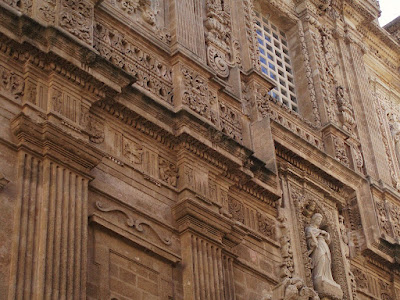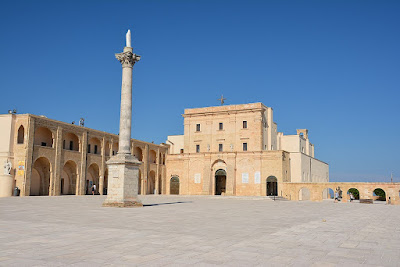Basilicas in Italy—Southern Apulia—1
I blogged about the following basilica on October 1, 2020.
- Cathedral Basilica of St. Cataldo, Taranto.
Cathedral Basilica of the Visitation and St. John the Baptist, Brindisi, Brindisi
Declared a minor basilica by Pope Pius IX in 1867.
The basilica is the cathedral for the Archdiocese of Brindisi-Ostuni. The Romanesque church was completed in 1143. The church was damaged by an earthquake in 1743 and rebuilt. It recently was once again renovated. It has a vase believed to be one of the wine containers involved in Jesus’ first miracle at Cana.
All pictures are from Wikipedia.
Basilica of the Holy Cross, Lecce, Lecce
Declared a minor basilica by Pope Pius X in 1905.
The Baroque church was built between 1549 and 1646. Sadly, the land was taken from the Jewish community who were then expelled from the city. The Celestine monks administered the church until the order was suppressed in 1807. The church became abandoned and then became offices for public officials. It was reopened as a church in 1833 by the Archconfraternity of the Holy Trinity.
Both pictures are from Wikipedia.
Cathedral Basilica of Our Lady of the Annunciation, Otranto, Lecce
Declared a minor basilica by Pope Pius XII in 1945.
The basilica is the cathedral of the Archdiocese of Otranto. The church was completed in the 11th Century and is mostly Romanesque although other styles were added in later centuries. A Turkish army conquered Otranto in 1480 and killed the cathedral’s clergy and all who had taken refuge there. Three days later, they beheaded over 800 people who refused to renounce their Catholic Faith. The church was converted first to a stable and then to a mosque before the Turks were expelled from Otranto in 1481.
All pictures are from Wikipedia.
Co-Cathedral Basilica of St. Agatha, Gallipoli, Lecce
Declared a minor basilica by Pope Pius XII in 1946.
The basilica is the co-cathedral for the Diocese of Nardo-Gallipoli. This 17th Century Baroque church replaced an earlier Romanesque church dedicated to St. John Chrysostom. This church was dedicated to St. Agatha. A relic of St. Agatha was said to be found in 1126—specifically one of her breasts which had been cut off during her torture and death. The relic was kept in the old church until 1380 when it was taken to a different church and has never been returned despite efforts by the people of Gallipoli. The church has many works of art and also has one of only five copies of the Shroud of Turin.
All pictures are from Wikipedia.
Basilica of St. John the Baptist, Lecce, Lecce
Declared a minor basilica by Pope Pius XII in 1948.
The basilica is built on the site of a 14th Century church and a convent of Dominican preaching friars. The current Baroque church was built in the 17th Century. The Dominicans left in 1821 and were replaced by the Congregation of the Rosary.
Pictures from TripAdvisor and Wikipedia.
Cathedral Basilica of the Assumption of Mary, Nardo, Lecce
Declared a minor basilica by Pope John Paul II in 1980.
The basilica is the cathedral for the Diocese of Nardo-Gallipoli. Portions of the church date to the 11th Century but it has been renovated and enlarged up until 1899.
Pictures are from Flickr and Wikipedia.
Basilica of St. Dominic Savio, Lecce, Lecce
Declared a minor basilica by Pope John Paul II in 1984.
Dominic Savio was a boy from Northern Italy who died at the age of 14. Known for his holiness, he was canonized in 1954. His canonization came about through his intercession for two mothers from the Lecce area who were healed from serious illnesses. The modern concrete basilica was built in the early 1970s.
Both pictures are from local sources.
Basilica of St. Mary “End of the Land,” Santa Maria di Leuca, Lecce
Declared a minor basilica by Pope John Paul II in 1990.
The church was built in the 18th Century and is located at the southeastern end of the Italian peninsula. Tradition has it that St. Peter landed here on his way to Rome. He converted the local people to Christianity and established a diocese in 59. The first church, built on the site of a Roman temple, was destroyed during a later persecution of Christians by the Romans. It is said that this early church had a painting of the Virgin Mary attributed to St. Luke that was destroyed during this time. Several more churches were built over the centuries.
The first pictures is from a local source and the others are from Wikipedia.

























No comments:
Post a Comment